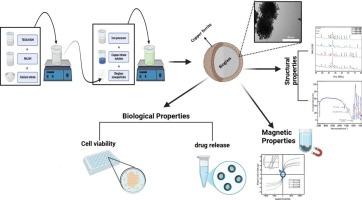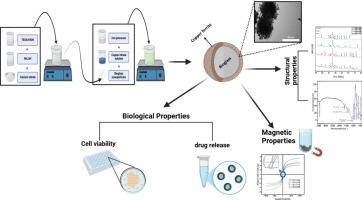铜铁氧体修饰生物玻璃纳米颗粒的合成:磁性、生物相容性和药物释放行为的研究
IF 6.9
2区 材料科学
Q2 CHEMISTRY, PHYSICAL
引用次数: 0
摘要
磁性涂层生物玻璃复合材料由于其在癌症治疗、药物输送和骨再生等方面的广泛应用而引起了人们的广泛关注。在本研究中,采用Stöber方法合成了均匀的球形SiO2-CaO生物玻璃纳米颗粒,然后采用液相沉积的方法在纳米颗粒表面包裹铁氧体铜。研究了不同浓度的铜前驱体(3 M, 4 M, 5 M, 6 M),以确定CuFe2O4纳米颗粒包覆生物玻璃颗粒的最佳浓度。5 M铜前驱体样品表现出最好的效果,x射线衍射分析中CuO和赤铁矿杂质最低,振动样品磁强计测试中饱和磁化强度最高,为7.5 emu/g。对涂层前后的生物玻璃颗粒进行了结构和形态研究,以证实其表面沉积了铁氧体铜。用不同浓度的铁酸铜包被生物玻璃对MG-63成骨细胞进行细胞毒性试验,证实了生物相容性,显示细胞增殖。分析了裸生物玻璃和cufe2o4包被生物玻璃对布洛芬的吸收和释放行为,药物释放谱符合Korsmeyer-Peppas模型,表明了Fickian释放机制。制备的磁性生物玻璃纳米复合材料具有很高的药物释放潜力,在生物医学领域具有广阔的应用前景。本文章由计算机程序翻译,如有差异,请以英文原文为准。


Synthesis of copper ferrite-decorated bioglass nanoparticles: investigation of magnetic properties, biocompatibility, and drug release behaviour
Magnetic bioglass composites have attracted considerable attention due to their versatile applications in cancer treatment, drug delivery, and bone regeneration. In this research, the Stöber method was used to synthesize homogeneous, spherical SiO2-CaO bioglass nanoparticles, which were then coated with copper ferrite nanoparticles using liquid phase deposition. Various concentrations of the copper precursor (3 M, 4 M, 5 M, and 6 M) were tested to find the optimal level for coating bioglass particles with CuFe2O4 nanoparticles. The 5 M copper precursor sample showed the best results, with the lowest CuO and hematite impurities in the X-ray diffraction analysis and the highest saturation magnetization of 7.5 emu/g in the Vibrating Sample Magnetometry test. Structural and morphological studies were conducted on the bioglass particles before and after coating to confirm the deposition of copper ferrite on their surfaces. Cytotoxicity assays on MG-63 osteoblast cells with varying concentrations of copper ferrite-coated bioglass confirmed biocompatibility and showed cell proliferation. The ibuprofen absorption and release behavior of both bare and CuFe2O4-coated bioglass was analyzed, and the drug release profile matched the Korsmeyer-Peppas model, indicating the Fickian release mechanism. The formed magnetic bioglass nanocomposites show high potential for drug delivery application, with prospective use for biomedical applications.
求助全文
通过发布文献求助,成功后即可免费获取论文全文。
去求助
来源期刊

Applied Surface Science
工程技术-材料科学:膜
CiteScore
12.50
自引率
7.50%
发文量
3393
审稿时长
67 days
期刊介绍:
Applied Surface Science covers topics contributing to a better understanding of surfaces, interfaces, nanostructures and their applications. The journal is concerned with scientific research on the atomic and molecular level of material properties determined with specific surface analytical techniques and/or computational methods, as well as the processing of such structures.
 求助内容:
求助内容: 应助结果提醒方式:
应助结果提醒方式:


